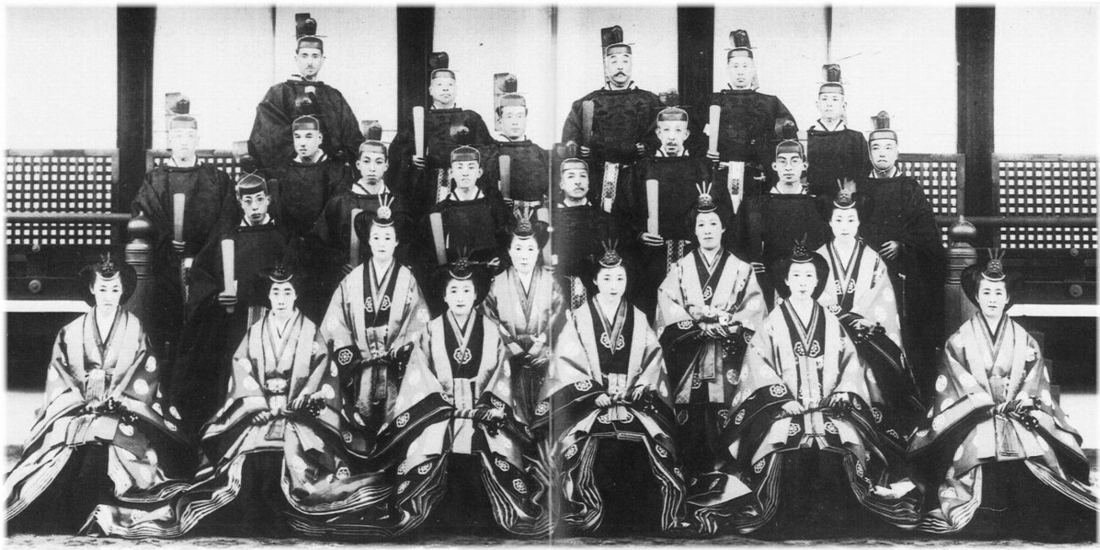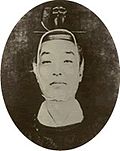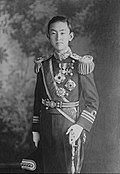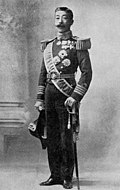Top Qs
Timeline
Chat
Perspective
Ōke
Branches of the Japanese Imperial Family From Wikipedia, the free encyclopedia
Remove ads
The Miyake (宮家; "Palace Houses") were branches of the Japanese imperial family (皇族 Kōka) created from branches of the Fushimi-no-miya house, the last surviving Shinnōke cadet branch. All but two (the Kan'in-no-miya and Nashimoto-no-miya) of these ōke (王家 "Royal Houses") were founded by the descendants of Prince Fushimi Kuniie, even if later those two were also descendants of Prince Kuniee genetically as his descendants were adopted into those families. The ōke were stripped of their membership in the imperial family by the American Occupation Authorities in October 1947, as part of the abolition of 11 collateral branches (imperial houses) with 51 members.[1] After that point, only the immediate family of Emperor Shōwa and those of his three brothers retained membership in the imperial family. However, unofficial heads of these collateral families still exist for most and are listed herein.
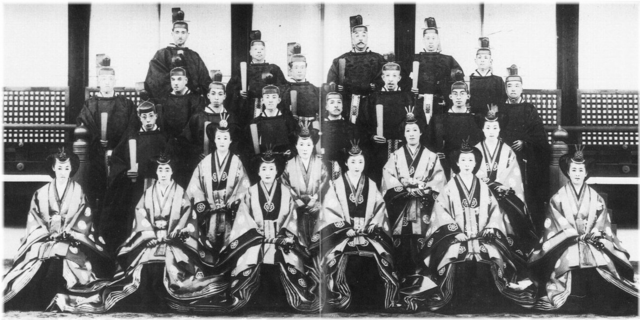

In recent years, as a solution to the Japanese succession controversy, conservatives have proposed to reinstate several of the former imperial branches or else to allow the imperial family to adopt male members of the former imperial princely houses.
Remove ads
List of ōke
Summarize
Perspective
The member houses until 1947 were, in order of founding:
- Fushimi (伏見)
- Kan'in (閑院) - extinct in 1988
- Yamashina (山階) - extinct in 1987
- Kitashirakawa (北白川) - extinct in 2018
- Nashimoto (梨本) - extinct in 1951
- Kuni (久邇)
- Kaya (賀陽)
- Higashifushimi or Komatsu (東伏見 / 小松) - extinct in 1922
- Asaka (朝香)
- Higashikuni (東久邇)
- Takeda (竹田)
Unless otherwise stated, all princes listed herein are the sons of their predecessor.
Fushimi-no-miya
The Fushimi-no-miya house was formed in 1409 by Prince Yoshihito.
The Fushimi-no-miya house is the ancestor of all the kyū-miyake families except Kan'in-no-miya.
Kan'in-no-miya
The Kan'in-no-miya house was formed in 1718 by Prince Naohito.
Nashimoto-no-miya
Prince Nashimoto Moriosa (1819—1885), 1st head of the Nashimoto-no-miya house
Prince Nashimoto Morimasa (1874—1951), 3rd head of the Nashimoto-no-miya house
The Nashimoto-no-miya house was formed by Prince Moriosa, son of Prince Fushimi Sadayoshi (father of Prince Fushimi Kuniye)
Kuni-no-miya
Prince Kuni Asahiko (1824-1891), 1st chapter of the Kuni no Miya house
Prince Kuni Asaakira (1901-1959), 3rd head of the Kuni-no-miya house
The Kuni-no-miya house was formed by Prince Asahiko, fourth son of Prince Fushimi Kuniye
Yamashina-no-miya

The Yamashina-no-miya house was formed by Prince Akira, eldest son of Prince Fushimi Kuniye.
The Yamashina-no-miya became extinct with the death of Yamashina Takehiko.
Kitashirakawa-no-miya
Prince Kitashirakawa Yoshihisa (1847-1895), 2nd head of the house of Kitashirakawa-no-miya
Prince Naruhisa Kitashirakawa (1887-1923), 3rd head of the house of Kitashirakawa-no-miya
The Kitashirakawa-no-miya house was formed by Prince Satonari, thirteenth son of Prince Fushimi Kuniye.
The Kitashirakawa-no-miya became extinct with the death of Kitashirakawa Michihisa without heirs on 20 October 2018.[2]
Higashifushimi-no-miya / Komatsu-no-miya
Prince Higashifushimi Yorihito (1867-1922)
Prince Komatsu Akihito (1846-1903), 1st head of the Komatsu no Miya house
The Higashifushimi-no-miya or the Komatsu-no-miya house was formed by Prince Yoshiaki, seventh son of Prince Fushimi Kuniye.
In 1931, Emperor Shōwa directed his brother-in-law, Prince Kuni Kunihide, to leave Imperial Family status and become Count Higashifushimi Kunihide (hakushaku under the kazoku peerage system), to prevent the Higashifushimi name from extinction. Dowager Princess Higashifushimi Kaneko became a commoner on 14 October 1947. She died in Tokyo in 1955.
Kaya-no-miya
Prince Kaya Kuninori (1867-1909), 1st chapter of the house of Kaya-no-miya
Prince Kaya Tsunenori (1900-1978), 2nd head of the house of Kaya-no-miya
The Kaya-no-miya house was formed by Prince Kuninori, second son of Prince Kuni Asahiko (first Kuni-no-miya, see above)
Asaka-no-miya

The Asaka-no-miya house was formed by Prince Yasuhiko, eighth son of Prince Kuni Asahiko.
Higashikuni-no-miya
Prince Naruhiko Higashikuni (1887-1990), 1st head of the Higashikuni-no-miya house
Higashikuni Morihiro (1917-1969), 2nd head of the Higashikuni-no-miya house
The Higashikuni-no-miya house was formed by Prince Naruhiko, ninth son of Prince Kuni Asahiko.
Prince Higashikuni Nobuhiko became simply "Higashikuni Nobuhiko" after the abolition of the Japanese aristocracy during the American occupation of Japan in 1947.
Takeda-no-miya
Prince Tsunehisa Takeda (1882-1919), 1st chapter of the house of Takeda-no-miya
Prince Tsuneyoshi Takeda (1909-1992), 2nd chapter of the house of Takeda-no-miya
The Takeda-no-miya house was formed by Prince Tsunehisa, eldest son of Prince Kitashirakawa Yoshihisa (second Kitashirakawa-no-miya).
Remove ads
Proposal for reinstatement
Summarize
Perspective
This section needs to be updated. (September 2017) |
In January 2005, Prime Minister Junichiro Koizumi set up a panel consisting of 10 experts from various fields to discuss the succession law and possible ways to ensure stable succession in the imperial family. At that point, no male heir had been born to the Imperial family in 40 years, prompting concerns that there wouldn't be anyone to succeed Crown Prince Naruhito after he became emperor. The panel recommended giving eligibility to females and their descendants, that the first child, regardless of sex, be given priority in ascension, and that female family members who marry commoners be allowed to retain their imperial family member status. Itsuo Sonobe, deputy chairman of the 10-member government panel and a former Supreme Court justice, said that one of the panel's main concerns had been to find a solution that would win the people's support.[3]
Media opinion polls showed an overwhelming majority favoring the change, but the proposed revision was met with fierce opposition from conservatives, who held that the imperial dynasty, which had survived in an unbroken line stretching for nearly 2700 years, could not be dismissed and ended by a wave of deracinated modernity and uncaring recentism. They proposed instead that the government take recourse to ancient traditions under which such situations had been handled in the past. They pointed out that various branches of the old imperial family do still exist in Japan, and that the constitutional definition of the "imperial family" which prevails today was imposed by the occupying western forces as recently as 1947. They maintained that, rather than ending the ancient imperial dynasty, it would be more sensible and less radical to end the recent, western-imposed restrictions. Tsuneyasu Takeda, a member of the former Takeda-no-miya collateral house (nephew of the current family head Tsunetada Takeda and son of Tsunekazu Takeda) and author of a book entitled The Untold Truth of Imperial Family Members, proposed to maintain the male line by restoring the former princely houses or by allowing imperial family members to adopt males from those families. Although Takeda has written that such men should feel a responsibility to maintain the royal house, he said he would find it daunting if asked to play that role himself.[4] According to Takeda, the heads of the former court families agreed in late 2004, just before Koizumi's advisory panel started its discussions, not to speak out on the issue and some of them told him to "not get involved in political issues".[5] Opponents of the reinstatement of former collateral branches, like Liberal Democratic Party politician Yōichi Masuzoe, argued that it would favor members of families with tenuous blood links to long-ago emperors over contemporary female descendants of recent sovereigns.[6]
During a series of hearings on the succession problem in early 2012, Yoshiko Sakurai and Akira Momochi, conservative members of the panel of experts, rejected proposals for female members of the imperial family to be allowed to retain their royal status after marriage and create new branches of the imperial family, and instead suggested revising the Imperial Household Law so that male descendants of former imperial families which renounced their royal status in 1947 be allowed to return to the imperial family as adoptees.[7] Another proposal was to reinstate four of the former imperial families,[8] a solution opposed by the government on the grounds that it would not enjoy public support.[9] Government sources told the Yomiuri Shimbun in May 2012 that the suggestion to reinstate men from the former princely houses as imperial family members through adoption had been unexpected.[10]
In September 2021, it was considered to amend the Imperial Household Law and allow the 85-year old Prince Hitachi to adopt a male member of the collateral branches of the imperial family.[11]
Remove ads
References
Bibliography
External links
Wikiwand - on
Seamless Wikipedia browsing. On steroids.
Remove ads
